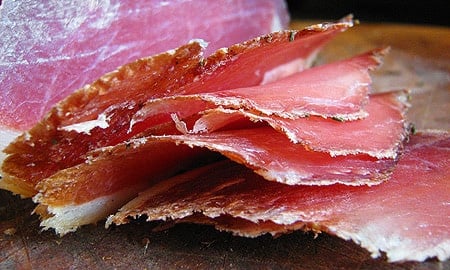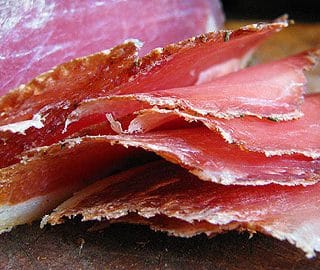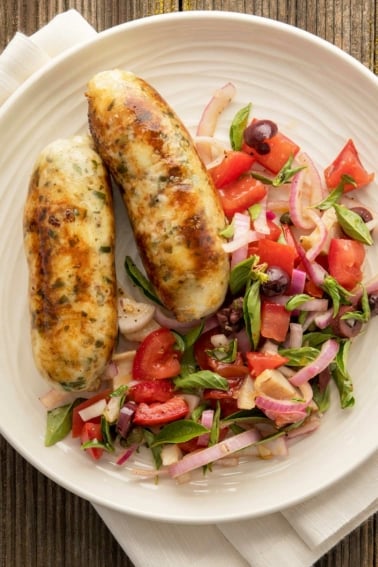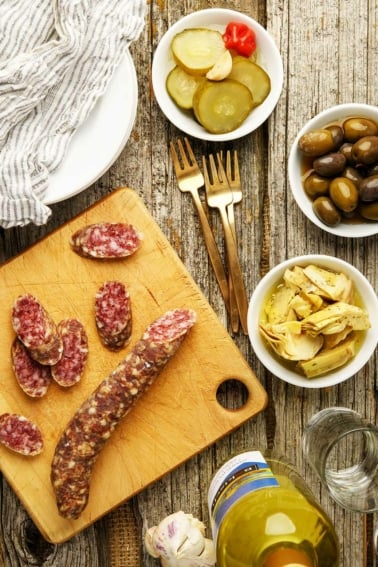As an Amazon Associate I earn from qualifying purchases.

Pork is the lone meat I still buy, in no small part because I have access to heritage pork raised the old way, with a varied diet and generally darker and fattier meat than that crap you get at the supermarket. I do routinely shoot wild hogs, too, and they are excellent for this recipe, Italian lonzino.
Lonzino is a fabulous dry-cured cut of pork that ages into a lovely pink, slices well and tastes not unlike a good cured ham. The Spanish call this same thing lomo. And if you coat the meat with a certain set of spices, it becomes the Armenian favorite basturma.
You use the loin of the pig for this recipe. Trimmed of all sinew, and, depending on your preference, fat. I prefer my lonzino lean, but some people love the fat v. lean you get with each bite. Either way works.
The coolest thing about lonzino is how easy and relatively quickly you can make it. Unlike prosciutto, which takes more than a year, lonzino can be ready in a month.
The only special equipment you need is curing salt and a cool place to hang your loins. You can get curing salt, Instacure No. 2 online, and your hanging place can be anywhere that isn’t bone dry (70 to 80 percent humidity is good) and is anywhere from 40°F to 60°F.
And like I mentioned at the beginning of this, you also need good pork. Lonzino highlights the innate qualities in your pork, so if it is factory-farmed you will very definitely notice – especially if it is put up next to a piece of quality pork. So do youself a favor and buy the good stuff.
Note that the time in the recipe does not include cure time.
A word on salt. You need to weigh your meat in grams and then weigh out 2.5 percent of that weight in sea salt or kosher salt, plus 0.25 percent, that’s one-quarter of one percent, in curing salt No. 2, which contains sodium nitrate. Weigh out an equal amount of sugar to the salt and add that to the mix.
Lonzino, Air Cured Pork Loin
Ingredients
- 1 length of pork loin, about 3 pounds
- kosher salt (see above)
- sugar (see above)
- InstaCure No. 2 (see above)
- 10 grams black pepper
- 5 grams garlic powder
- 5 grams ground cloves
- 10 grams onion powder
- 8 grams dried thyme
Instructions
- Mix all the dry ingredients. Rub them well into the loin, then put the meat into a plastic bag or wrap with plastic wrap. This is to keep it from drying out. Keep the meat refrigerated for a week to 12 days.
- When the meat has firmed up, remove from the wrap, rinse it off and then let it dry on a rack for 2 to 3 hours. I use a portable fan set on low to oscillate over the meat.
- Truss the meat with kitchen twine (the white stuff) as you would a roast. Leave a long loop at one end so you can hang the meat. You can also use pre-made sausage netting.
- Hang the meat in a cool place to dry. It needs to be humid, about 70 percent humidity. How long? At least another 12 days. It should feel firm throughout and be a pleasing red. How long can you hang it? Up to six months or more, but it will become harder and drier the longer it hangs. If you've found you have dried it too much, let it go all the way to hard-as-a-rock stage. Then use a microplane grater to grate the dried meat over pasta or rice.
- To store: Wrap tightly in butcher paper or, better yet, vacuum seal pieces of it – I cut the loin into three chunks – and freeze. Unfrozen, it will last indefinitely in the fridge, but it will continue to dry out.
Notes
Nutrition information is automatically calculated, so should only be used as an approximation.






Hello Hank,
I’d like to say thank you
For a great recipe.
I’d also like to ask if I use a larger
Cut of pork like a boned rolled leg. How much more if the recipe would I need to use ?
Thanks
Nejat
Hi All,
Hank,thank you for the wonderful information! A big AMEN about the quality of meat to use to get the best results. I was reading all of the questions and comments about casing/no casing and hanging methods. We buy ladies knee hi stockings to hang them in. No casing needed and the meat does not attach to the stocking. Just tie the end of the stocking to your hanging pole. It has worked well for us.
Thanks Hank for the blog and the response even after the years. Admirable to say the least. Ever tried to weigh the evaporation of the 35% or just stuck to the (12 day timer)? I do like more a more firm type of texture, so can I let it go longer. Thumbs up on the humidity level (got the perfect invention to keeping that as stated). Think a thin paper bag (lunch type) would be okay? Seen a video with that technique, just wonder thoughts on if the meat would moisten the bag which might then promote bacteria growth. Do not want to have direct air contact but wish not to case it either. Tried cheesecloth but it was hard to get off once ready. Served its purpose but……. Again your the bomb, enjoyed reading and the comments!
What is your invention for humidity?
Lazaro: Invention? Not sure what you mean. If you mean how do I control it, I use a humidifier. My preference is about 75%.
I noticed you did not use any casing (natural or otherwise) and just instructed to truss the meat before hanging. I have read something of using a paper bag (the ones that are thin you would pack a school lunch in), what are your thoughts about that? Also you say cool environment, from reading others blogs I am thinking 50-60 degrees F? (but all other recipes I have found had a casing). Lastly you say, ” 12 days of hanging time”, I am seeing 35% loss of weight as ideal, but again that nasty (casing) creeps in and I wonder if that plays a role in the month to get to 35% weight loss vs your 12 days with “no casing” difference? Love to hear your input so I can get my started. Thank you for your time.
Tim: Hang closer to 50F. And yes, it will dry faster with no casing. But you also need to keep a relatively high humidity so you don’t get case hardening, which is when the outside dries faster than the inside.
I just made some Lonzino and the brilliant pink color was missing. I followed your recipe to the letter. Temp was set at 55 degrees and RH at 75% with little variation during the whole process. The flavor was good but not as tasty as the Lonzino I brought from Europe. Would the difference rests on using wild pigs from Europe vice regular pig’s meat from our US market. If so: is there any place you may recommend to purchase the raw meat directly from Europe that will ship to the US?
Angel: Pork quality absolutely matters. The lonzino you see in the picture is a wild hog I shot in California. The other thing that might be going on is age. A long aged lonzino will be more complex in flavor than one aged only a couple months.
I just tried my first hand at curing meats. I had about 8 pieces of meat, none anymore than half a pound, I buried them in salt for 2 days in the fridge, then hung them up for about 3 weeks in my fridge….they all came out nice, some a little salty, the beef pieces didn’t have as pretty of color than the pork….my question is should I use a prague powder for this method? would I need to change up my methods if I do use a #2 ?
Corey: I use a bit of No. 2 in most of my long cured recipes.
Should I trim the outside 1/16 inch. Or does the instant cure make it edible?
Peter: It should be fine.
Do I need to worry about trichinosis with this recipe? Bear meat specifically
Scott: It can be tricky with bear. I would be hesitant to make this with a bear backstrap.
Hi Hank! Another quick question. My Lonza has gone through the required drying process and time. It has a lot of good mold covering it. Do I remove this? And if so what is the correct procedure to do so? Thanks again!!!
Marcel: I leave it on.
Is it necessary to wrap the Lonza in cheese cloth or stuff in some sort of casing? I have seen some recipes that do this and some that don’t. What is the reason to do this step?
Marcel: No.
This was my first attempt at curing. After 12 days of hanging, I sliced off a little bit. It is still soft in the middle so I hung it back up to let it dry out more. I think the humidity may be too low. Anyway, I like the way it tastes, but may be a little too clove forward for me. Next time I may leave the cloves out. Thanks Hank for your recipe!
I didn’t use any sugar when I did the recipe. Is the sugar really necessary? I used summer savoury as the herb rub. Have you tried that?
Mary: You’ll be fine without it.
How do you insure that wild hog loins are free from trichinosis and any other parasites?
Charcutodd: You freeze them first, which helps a lot with the trich species in hogs, and then the salt level does the rest.
Why grams? We’re in USA.
Can any cut of pork be substituted?
Matt: Grams for precision. I am in the USA, too. You simply can’t get the precision you need in English units. And no, not any cut will work. This is for loin only.
I’ve got a great 3-5lb locally raised pork leg roast that I was given. It’s decently lean but does have some fat on one side and some through the middle. This recipe should work fine I believe, right? I’ve been looking for a somewhat quick cure/approach to do with it.
Ryan: Seems like it would work. Just make sure it dries out very very slowly, so the outside doesn’t get hard before the center dries. Keep your humidity high.
Looks like a great recipe and technique . As far as the Basturma comment goes Armenian basturma is made only with beef and never with pork but I may give it a try to see how pork will work out.
Shouldn’t you use pink salt instacure #1 as your curing is only 14 days?
Gamehawg: You might be right, but I’ve always used No. 2 with good success.
Have you tried lightly smoking the loin before hanging to dry?
Eugene: Yes, I have. It works well!
Just curious, I believe the recipe used to have a 3lb weight for the loin?
Jared: Nope, it did not.
I did pork butts last year starting end of January. salted 2 days then ringed, peppered wrapped in casing and hung in the attic for a couple of months . No curing powder. is it too late to do that again this year starting them now ?
Hi,
I’ve just followed your Lonzino recipe but for less than half the weight of loin. (and the proportional amounts of salt etc). Do I reduce the refrigeration and hanging/drying time accordingly?
Thanks
Matt: Yes.
Hank,
I bough a loin for a total of 7.4 lbs cleaned. The bags I had limited what I could do so the pieces are 2.8; 2. 5 and 2.1 lbs. it looks as I have to reduce the time in the refrigerator and curing time. Is that right?
Angel: Bags? Not sure what you mean.